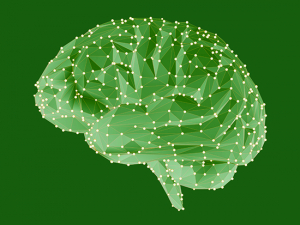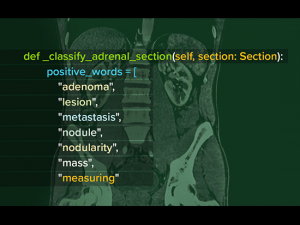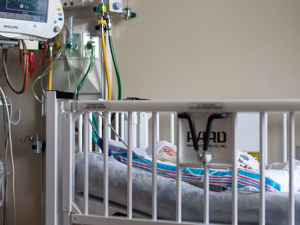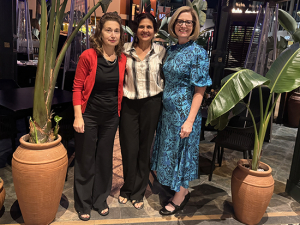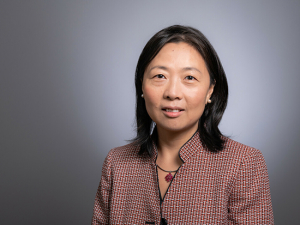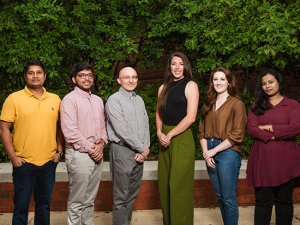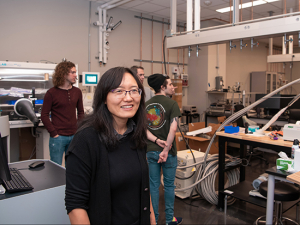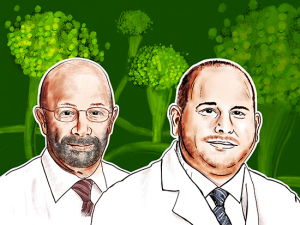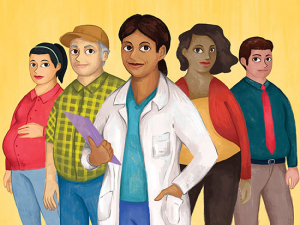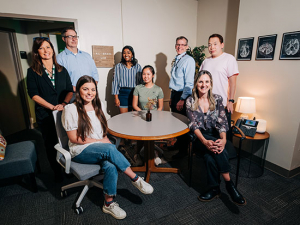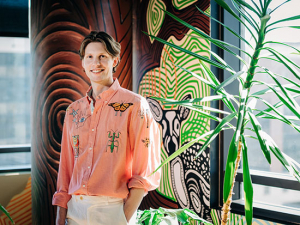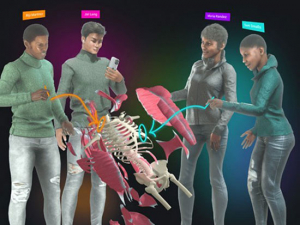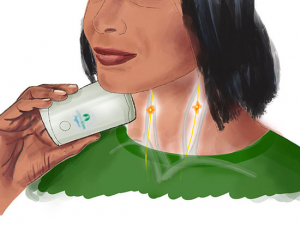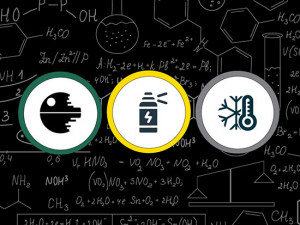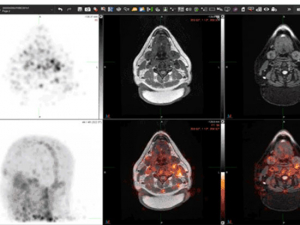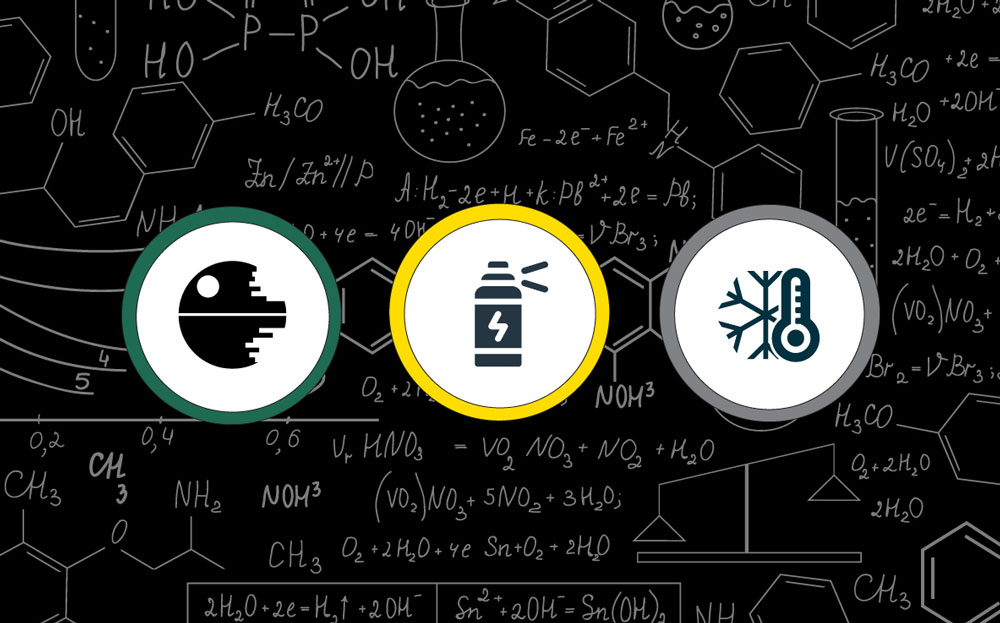
Movie stars obsess over chemistry. But if you measure thrills and chills per square inch, nothing beats the real thing.
Like the Rebel Alliance in Star Wars, one UAB chemist has developed a way to smuggle secret plans into the heart of cancer cells and shut down their defenses. Her colleague, inspired by numbing knee spray, is leveraging UAB’s supercomputer in a quest to prevent metastasis. Down the hall, a third chemist is flash-freezing reactions to disrupt a scheme that cancer cells rely on to outwit the immune system.
At UAB, the Department of Chemistry is a major force in the fight against cancer. “Chemistry is the bridge between the basic sciences and the applied life sciences,” said Richard Dluhy, Ph.D., professor and department chair. Chemistry is at the heart of the transformative discoveries and technologies that will change society in the 21st century, including medicines, genomics, biotechnology, advanced materials and energy, Dluhy says.
"The strength of chemistry is diversity. Chemists think in targeted applications, not one-size-fits-all."
Students get a front-row seat for this work. In 2020, the department joined with the Heersink School of Medicine to launch the nation’s first undergraduate degree in cancer biology.
Drug discovery is a primary focus for the department’s research, and more than a third of chemistry faculty hold positions as scientists in the O’Neal Comprehensive Cancer Center at UAB. “The strength of chemistry is diversity,” said Eugenia Kharlampieva, Ph.D., Distinguished Professor in the Department of Chemistry and senior scientist in the O’Neal Comprehensive Cancer Center. “Chemists think in targeted applications, not one-size-fits-all. We design our materials from the smallest building blocks, so we can tune them and play with them to meet the need.”
The Department of Chemistry is one of the best-equipped in the Southeast, Kharlampieva added. “UAB is uniquely suited to do this work: We have strong basic science, the medical school, the Cancer Center, immunologists, biologists. And as a young university, we have less bureaucracy, which really helps with collaborations.”
Below, Kharlampieva and two other chemistry faculty describe some of their latest cancer research and the equipment they use to move the projects forward.
Nothing to see here
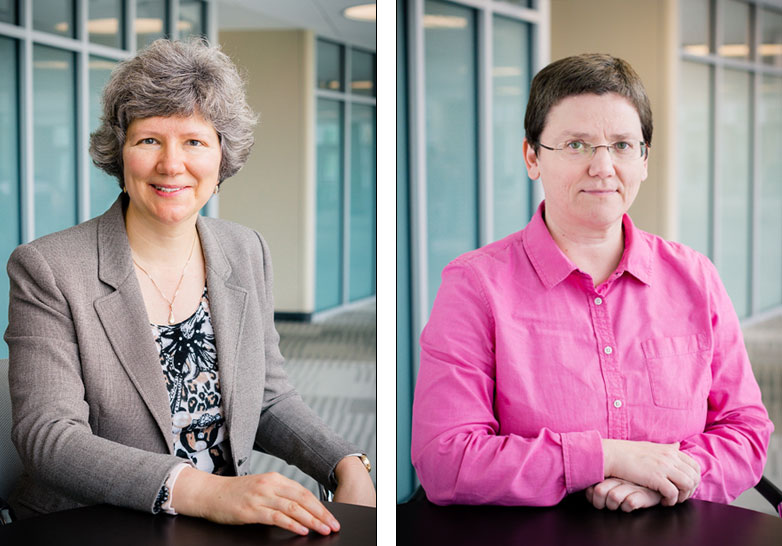 Eugenia Kharlampieva, Ph.D. (left), and Veronika Kozlovskaya, Ph.D. (right). "Veronika and I are in the chemotherapy business," Kharlampieva said.Kharlampieva and Veronika Kozlovskaya, Ph.D., research associate in Kharlampieva’s lab and her longtime collaborator, have created a cloaking device for fragile anti-cancer drugs. Their nanocapsules can be 60 times smaller than a red blood cell and produced at industrial scale. And they are smart; that is, they can release their cargo at precise locations when triggered by a burst of ultrasound energy, a specified temperature or the acidic environment around cancer cells.
Eugenia Kharlampieva, Ph.D. (left), and Veronika Kozlovskaya, Ph.D. (right). "Veronika and I are in the chemotherapy business," Kharlampieva said.Kharlampieva and Veronika Kozlovskaya, Ph.D., research associate in Kharlampieva’s lab and her longtime collaborator, have created a cloaking device for fragile anti-cancer drugs. Their nanocapsules can be 60 times smaller than a red blood cell and produced at industrial scale. And they are smart; that is, they can release their cargo at precise locations when triggered by a burst of ultrasound energy, a specified temperature or the acidic environment around cancer cells.
In a way, these delivery vehicles are similar to the protective spheres of fat — liposomes — that shield messenger RNA in Pfizer’s and Moderna’s COVID vaccines. “But the purpose is totally different,” Kharlampieva said. “We want to hide drugs from the immune system.” And unlike the nanocapsules made in her lab, “liposomes are immunogenic, not reproducible and the size cannot be reliably controlled.” Kharlampieva and Kozlovskaya are polymer chemists — specializing in producing tailored organic materials. “Polymers are the most adaptable systems,” Kozlovskaya said. “They can be biodegradable, biomimetic, water-soluble and non-immunogenic.”
Kharlampieva’s lab has created a cloaking device for fragile anti-cancer drugs. Their smart nanocapsules can release their cargo at precise locations when triggered by a burst of ultrasound energy, a specified temperature or the acidic environment around cancer cells.
The lab’s capsules have been customized to carry treatments for diabetes, scavenge damaging reactive oxygen species and even soak up oil spills. The researchers are in the midst of an exciting collaboration with Suzanne Lapi, Ph.D., professor and vice chair of Translational Research in the Department of Radiology and director of the UAB Cyclotron Facility and UAB Radiochemistry Laboratory. They are using one type of nanocapsule, known as a polymersome, to combine diagnostic PET imaging and drug delivery in one. “Veronika and I are in the chemotherapy business,” Kharlampieva said. “Suzy has access to surgery and radiotherapy and real patients. This is an opportunity to move our systems forward and truly affect patient care.”
Polymersomes have created quite a following among UAB cancer clinicians and researchers because they have the potential to overcome many types of drug delivery issues. The Kharlampieva lab has an ongoing partnership with Eddy Yang, M.D., Ph.D., professor in the Department of Radiation Oncology and co-leader of the Cancer Center’s Experimental Therapeutics program.
Yang hopes to overcome drug resistance in his patients by tapping the power of silencing RNAs. Also known as small interfering RNAs, and as siRNAs for short in either case, these can latch on to messenger RNA (mRNA) transcripts in cells and prevent that code from being translated into proteins. Yang is targeting a DNA repair enzyme known as PARP1 in cancer cells. Cells that cannot repair their DNA are killed, and cancer cells make a lot of DNA errors, so they rely on PARP1 production to survive. By delivering siRNA to cancer cells, Yang aims to throttle their supply of PARP1; this could be especially effective in stopping breast cancer cells that have become resistant to standard therapies.
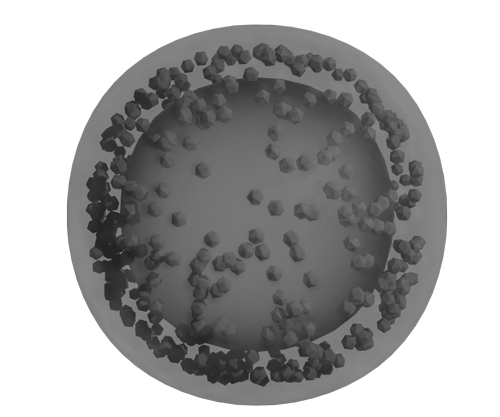 But siRNA, like the mRNA used in COVID vaccines, cannot reach cells on its own. For one thing, the bloodstream is filled with enzymes that specifically target free-floating RNA. Also, siRNA is not efficiently taken up by cells, and it has poor tissue and cell specificity, among other problems.
But siRNA, like the mRNA used in COVID vaccines, cannot reach cells on its own. For one thing, the bloodstream is filled with enzymes that specifically target free-floating RNA. Also, siRNA is not efficiently taken up by cells, and it has poor tissue and cell specificity, among other problems.
Although at least 21 siRNA-based therapeutics have been developed for cancer and other diseases, clinical trials have had limited success.
Enter the polymersomes. In their latest study, published in May 2022, Kharlampieva, Yang and co-investigators explained how they used 100-nanometer-wide polymersome capsules, with walls 13 nanometers thick, to carry PARP1 siRNA into triple-negative breast cancer tumors in mice. Upon arrival, the siRNA was released due to the polymersomes’ degradability, and the treatment brought a fourfold increase in survival.
The experiments took place in Yang’s lab, but before this final step the Kharlampieva team had tapped equipment and expertise across campus and beyond. The process they have developed to build their nanocapsules is fairly well standardized now; but this application required robust walls to shield the siRNA, new techniques to coax the siRNA into the self-assembling capsules and experiments to verify how much siRNA was making it into each capsule. (For more, see “Ways of seeing the invisible” below.)
Biochemist Jun Zhang, Ph.D., assistant professor in the Department of Chemistry, “trained my students to encapsulate siRNA,” Kharlampieva said. “It is very fragile; if you just look at it, it starts to degrade. We also needed his skills to confirm that the siRNA, once encapsulated, was not damaged in the process.”
Kharlampieva, fittingly for someone in the delivery business, uses a transportation metaphor to summarize the group effort involved in this research. “We built the car, Dr. Zhang put the engine in, and Dr. Yang did the test drive,” she said.
Ways of seeing the invisible
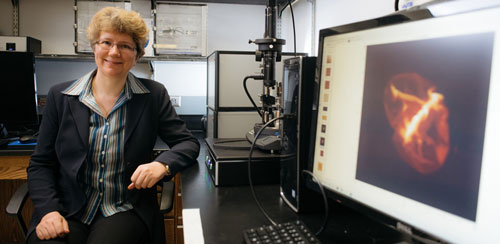 Kharlampieva with atomic force microscopePolymersomes are just the right size to slip into cells. But verifying that these tiny cargo pods are built and functioning correctly requires an arsenal of high-tech scientific gear. In their 2022 study using polymersomes loaded with PARP1 siRNA, the Kharlampieva lab performed:
Kharlampieva with atomic force microscopePolymersomes are just the right size to slip into cells. But verifying that these tiny cargo pods are built and functioning correctly requires an arsenal of high-tech scientific gear. In their 2022 study using polymersomes loaded with PARP1 siRNA, the Kharlampieva lab performed:
- transmission electron microscopy at UAB’s High-Resolution Imaging Facility (for images of empty and PARP1 siRNA-loaded polymersomes before and after ultrasound treatment);
- dynamic light scattering using the ZetaSizer instrument in the Kharlampieva lab’s Nanomaterials/Surface Characterization Facility (to measure the diameters of the polymersomes);
- atomic force microscopy in the UAB Center for Nanoscale Materials and Biointegration, where Kharlampieva is co-director (for imaging empty and siRNA-loaded polymersomes and measuring polymersome heights);
- small-angle neutron scattering at Oak Ridge National Laboratory in Tennessee (to determine the thickness of the polymersome walls); and
- fluorescent imaging in the lab of Jason Warram, Ph.D., associate professor in the UAB Department of Otolaryngology (for images of the siRNA-filled polymersomes located within tumors in animal models).
Metal mimics
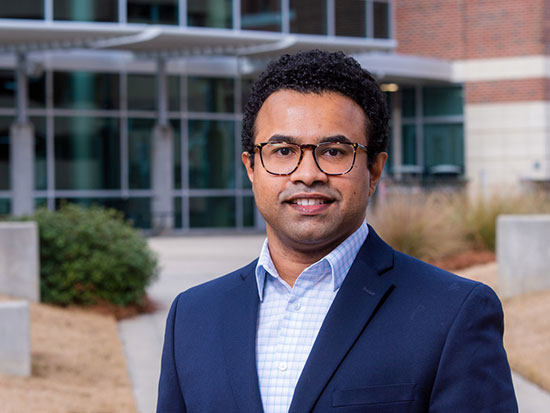 Gayan Wijeratne, Ph.D., specializes in metal-based enzymes, particularly the hotly debated workings of TDO and IDO, which are implicated in helping cancer cells grow faster at very early stages.Finding new targets for cancer drugs — to reduce side effects, combat resistance and improve their killing power — relies on basic research. Gayan Wijeratne, Ph.D., assistant professor of chemistry and associate scientist in the O’Neal Comprehensive Cancer Center, studies cancer development and progression at the molecular level.
Gayan Wijeratne, Ph.D., specializes in metal-based enzymes, particularly the hotly debated workings of TDO and IDO, which are implicated in helping cancer cells grow faster at very early stages.Finding new targets for cancer drugs — to reduce side effects, combat resistance and improve their killing power — relies on basic research. Gayan Wijeratne, Ph.D., assistant professor of chemistry and associate scientist in the O’Neal Comprehensive Cancer Center, studies cancer development and progression at the molecular level.
“Which exact molecules are involved? When you go down to the molecular level, how exactly does cancer start? These are questions that chemistry can answer,” Wijeratne said. He specializes in metal-based enzymes. Their chemistry can be so complex and contentious that he has pioneered the use of mimics — simplified versions of the active sites of real biological proteins that are designed for easier manipulation in the lab.
One hotly discussed niche in cancer drug research is the tryptophan-kynurenine pathway. Tryptophan, one of the eight essential amino acids, goes in at one end, and several steps later out come a variety of products. The all-important first step, which controls everything else that follows, is catalyzed by two iron-based heme enzymes, tryptophan 2,3-dioxygenase, or TDO, and indoleamine 2,3-dioxygenase, or IDO.
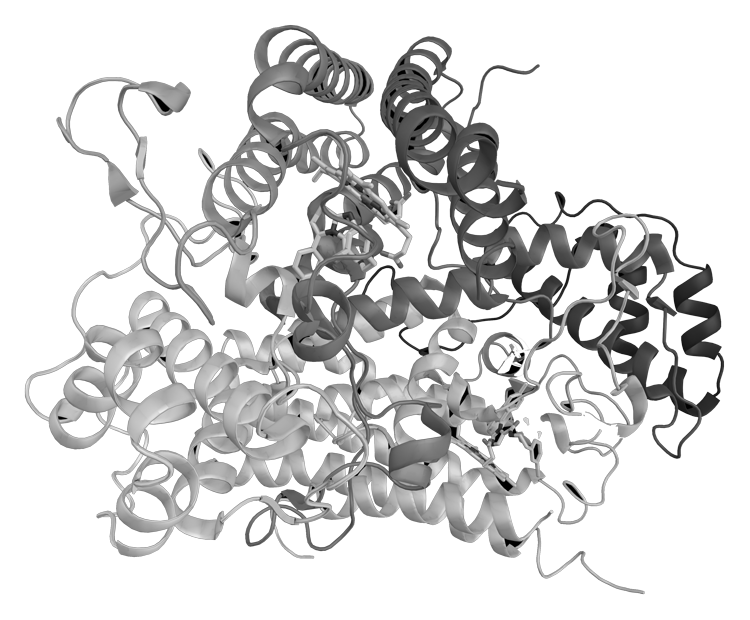 Research shows that TDO and IDO activity in human T cells can explain why these key immune foot soldiers often stand down just as tumors are getting started. “That helps cancer cells grow faster at a very early stage,” Wijeratne said. Several studies have shown that TDO and IDO are overexpressed in many cancers, including brain, lung and breast cancer. “There is a lot of research into how to block these tryptophan-degrading enzymes so that our immune system can identify the cancer in an early stage and break it apart,” Wijeratne said.
Research shows that TDO and IDO activity in human T cells can explain why these key immune foot soldiers often stand down just as tumors are getting started. “That helps cancer cells grow faster at a very early stage,” Wijeratne said. Several studies have shown that TDO and IDO are overexpressed in many cancers, including brain, lung and breast cancer. “There is a lot of research into how to block these tryptophan-degrading enzymes so that our immune system can identify the cancer in an early stage and break it apart,” Wijeratne said.
To block an enzyme effectively, you need to know how it works. “But these enzymes have been a black box for many decades,” Wijeratne said. “They are extremely efficient, which is not very helpful when you study how exactly they work — they work too quickly, so you can’t really follow what is happening during turnover.”
Wijeratne's lab-designed mimics of TDO and IDO allow him to slow down the chemical changes to the point that they can be mapped out. “The hope is that, once we have the mechanistic findings, we will be able to design drugs to block them."
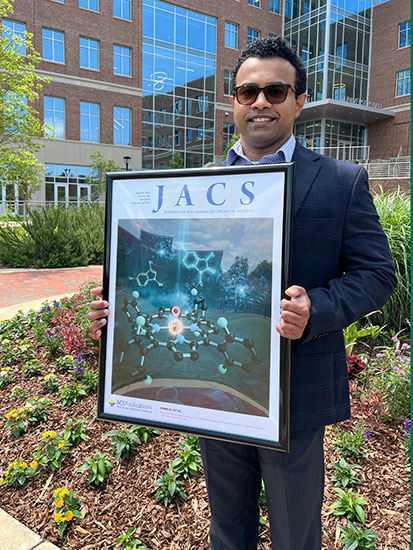 Wijeratne's work was featured on the cover of the prestigious Journal of the American Chemical Society in 2022.Recently, however, Wijeratne has made a breakthrough using simpler, lab-designed mimics of TDO and IDO that allow him to slow down the chemical changes to the point that they can be mapped out. “That is why the Cancer Center wanted me to be in their immunology group,” Wijeratne said. “The hope is that, once we have the mechanistic findings, we will be able to design drugs to block them, especially those that specifically target the mechanism.”
Wijeratne's work was featured on the cover of the prestigious Journal of the American Chemical Society in 2022.Recently, however, Wijeratne has made a breakthrough using simpler, lab-designed mimics of TDO and IDO that allow him to slow down the chemical changes to the point that they can be mapped out. “That is why the Cancer Center wanted me to be in their immunology group,” Wijeratne said. “The hope is that, once we have the mechanistic findings, we will be able to design drugs to block them, especially those that specifically target the mechanism.”
In a 2020 paper in the Journal of the American Chemical Society, “my postdoctoral research associate, Dr. Pritam Mondal, generated some important insights,” Wijeratne said. These include identifying an intermediate species, Fe(IV)-oxo, that forms after the O—O bond breaking of the heme superoxide active species. These insights could be implemented in designing new drug targets that efficiently block TDO/IDO enzymes.
“Our small-molecule mimics have been able to show a lot of details that have not been seen before,” Wijeratne said. “We started off with a very basic model, and now we are building our models further to be closer to the enzyme active site itself.”
That paper led to numerous invitations to speak at research symposia. It also sparked a collaboration with Syun-Ru Yeh, Ph.D., of the Einstein College of Medicine in New York City, who is a leading researcher on the structure, function and inhibition of TDO and IDO enzymes. A 2022 JACS paper by Wijeratne, Mondal and graduate student Shanuk Rajapakse shared results from experiments with other heme enzyme mimics that could also benefit future cancer drug synthesis. The work was featured as the journal’s cover illustration. “Our latest work is described in a new paper modeling the heme enzyme nitric oxide synthase, which, like TDO and IDO, is implicated in cancer generation and progression,” Wijeratne said. Their paper was recently published in a leading journal, Angewandte Chemie International Edition.
How do you create an enzyme model?
1. Back to basics. “We start by going back to the enzyme and looking at crystal structures very closely,” Wijeratne said. “Synthesizing our mimics,” which are a simplified version of the natural enzyme, “involves very basic organic chemistry; but it is very challenging, because it is not the most chemically favorable way to do things,” he said. “We’re having to force it.”
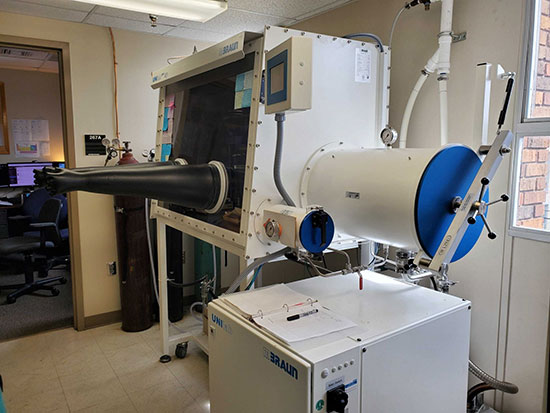 One of the Wijeratne lab's two glove-box systems. Image courtesy Wijeratne lab.2. No O2 allowed. “You can’t work on these models on the benchtop,” Wijeratne said. “Oxygen will break them apart. We use what are called Schlenk techniques. We have two glove-box systems, filled with an inert gas such as nitrogen or argon, and you work on chemicals inside the box using the rubber gloves attached to it. It’s pretty tricky to do that kind of chemistry; if you get any oxygen in the box, everything is gone.”
One of the Wijeratne lab's two glove-box systems. Image courtesy Wijeratne lab.2. No O2 allowed. “You can’t work on these models on the benchtop,” Wijeratne said. “Oxygen will break them apart. We use what are called Schlenk techniques. We have two glove-box systems, filled with an inert gas such as nitrogen or argon, and you work on chemicals inside the box using the rubber gloves attached to it. It’s pretty tricky to do that kind of chemistry; if you get any oxygen in the box, everything is gone.”
3. Get cold. “The next step is to seal everything in the glove box and study the mechanism in a cryostat hooked up to liquid nitrogen,” Wijeratne said. “We cool it to minus 80 degrees Celsius or even colder, then add tryptophan mimics like indoles and see the reaction in a monitor. You can measure the change in visible parameters, i.e., color, over time. We do that at very low temperatures so that we can see intermediates that you might not be able to see in the protein. Then we can characterize those intermediates using various spectroscopic methods.
“The intermediates are very reactive. When you cool them, you slow them down. But even in these colder temperatures, the intermediate builds up and goes away. If we see it build up, we freeze the sample to shut down the reaction. We also let the reaction go forward and then characterize what was made in the end.”
4. Nuclear option. “If we see something interesting, we can do low-temperature NMR — nuclear magnetic resonance — which uses a powerful magnetic field to characterize the sample,” Wijeratne said. UAB’s Central Alabama High-Field NMR Facility is one of the best-equipped such centers in the Southeast. Its centerpiece Bruker Avance III-HD 850-megahertz spectrometer is just one of seven spectrometers in the Chemistry Building.
5. Even colder. “We also work with Professor Mary Ellen Zvanut in the Department of Physics, who does electron paramagnetic resonance spectroscopy using liquid helium that goes to minus 200 degrees Celsius,” Wijeratne said. “We have studied our models with resonance Raman spectroscopy in collaboration with Syun-Ru Yeh’s lab, and we do computational modeling of reaction landscapes either in collaboration with the Alabama Supercomputing Cluster in Huntsville or with Professor Sam de Visser’s group” at the University of Manchester in England.
Power shift
Chemists specialize in creating small-molecule drugs, which remain the mainstay of cancer treatment even in the era of immunotherapy. “Small-molecule drugs are simple organic molecules that we can make in the lab to target unique aspects of tumors,” said Sadanandan Velu, Ph.D., professor of chemistry and scientist in the Cancer Center’s Experimental Therapeutics Program. “They bind to active sites of the target proteins in the cells and inhibit them.”
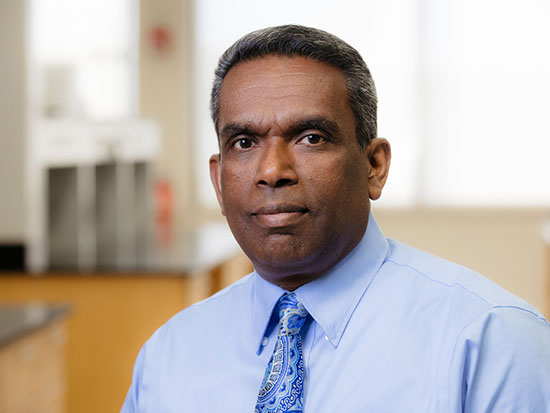 There are no current treatments for cancer metastasis. But in his lab, Sadanandan Velu, Ph.D., is exploring the possibilities of voltage-gated sodium channels — the same channels targeted by numbing spray.One way to identify new cancer drugs is by looking to natural sources that contain compounds with cytotoxic (cell-killing) effects. Marine natural products, obtained from invertebrates such as sponges, soft corals and the tube-like ascidians, have been a longtime research interest for Velu’s lab. “The marine environment has undergone unique biological and chemical evolution, very different from land-based life,” Velu said. “The sedentary lifestyle of marine organisms has necessitated the evolution of chemical means for their defense.” Velu’s lab has leveraged toxins from marine sponges to discover potential drugs for breast cancer, prostate cancer, ovarian cancer, neuroendocrine cancer and pancreatic cancer, all of which are in ongoing studies.
There are no current treatments for cancer metastasis. But in his lab, Sadanandan Velu, Ph.D., is exploring the possibilities of voltage-gated sodium channels — the same channels targeted by numbing spray.One way to identify new cancer drugs is by looking to natural sources that contain compounds with cytotoxic (cell-killing) effects. Marine natural products, obtained from invertebrates such as sponges, soft corals and the tube-like ascidians, have been a longtime research interest for Velu’s lab. “The marine environment has undergone unique biological and chemical evolution, very different from land-based life,” Velu said. “The sedentary lifestyle of marine organisms has necessitated the evolution of chemical means for their defense.” Velu’s lab has leveraged toxins from marine sponges to discover potential drugs for breast cancer, prostate cancer, ovarian cancer, neuroendocrine cancer and pancreatic cancer, all of which are in ongoing studies.
Another way to develop drugs is to target a critical mechanism in cancer growth or metastasis and then rationally design a small molecule that can stop it. Velu’s lab has followed this route in search of a drug that interferes with metastasis — the spread of cancer throughout the body.
“Most people die when their cancer has metastasized, not from the cancer that was initially detected at the primary site,” Velu said. “There are no current treatments for metastasis. But if we can figure out a way to contain the tumor to the primary site, people could survive with [existing] chemotherapeutic agents.”
An intriguing theory of cancer metastasis: Acidity caused by malfunctioning voltage-gated sodium channels triggers activation of enzymes that help cancer cells "break out and detach from their original site," Velu said. He is targeting these channels with small-molecule drugs.
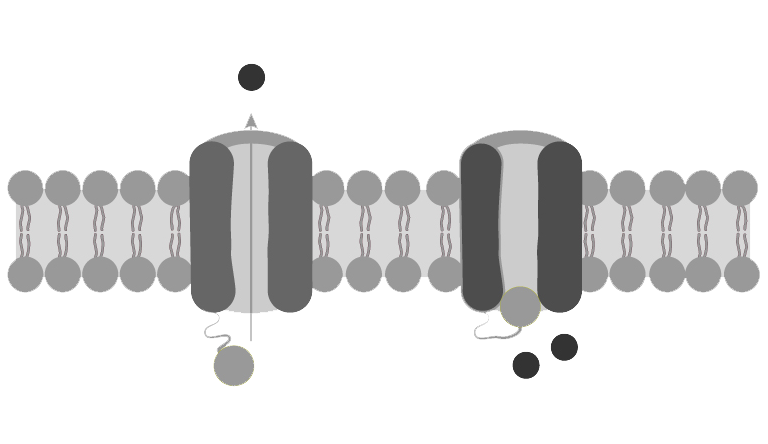 Velu’s project is focused on an intriguing theory about why metastasis happens. It revolves around transmembrane proteins known as voltage-gated sodium channels. These channels are located in the outer membranes of cells, where they maintain the balance of electrical charges inside and outside the cell. The channels transport positively charged sodium ions into the cell, which promotes an enhanced flow of hydrogen ions in the opposite direction. When the channels malfunction, the microenvironment around the tumor can become acidic. This acidity, in turn, triggers the activation of proteolytic enzymes, which damage the extracellular matrix that holds cells in place. “This helps cancer cells break out and detach from their original site,” Velu said. “Then they travel through the bloodstream or lymph system to other locations in the body and start building new tumor sites.” One way to slow or stop cancer metastasis, therefore, could be to target these voltage-gated sodium channels with small-molecule drugs.
Velu’s project is focused on an intriguing theory about why metastasis happens. It revolves around transmembrane proteins known as voltage-gated sodium channels. These channels are located in the outer membranes of cells, where they maintain the balance of electrical charges inside and outside the cell. The channels transport positively charged sodium ions into the cell, which promotes an enhanced flow of hydrogen ions in the opposite direction. When the channels malfunction, the microenvironment around the tumor can become acidic. This acidity, in turn, triggers the activation of proteolytic enzymes, which damage the extracellular matrix that holds cells in place. “This helps cancer cells break out and detach from their original site,” Velu said. “Then they travel through the bloodstream or lymph system to other locations in the body and start building new tumor sites.” One way to slow or stop cancer metastasis, therefore, could be to target these voltage-gated sodium channels with small-molecule drugs.
Story continues after box
Computer-aided drug discovery
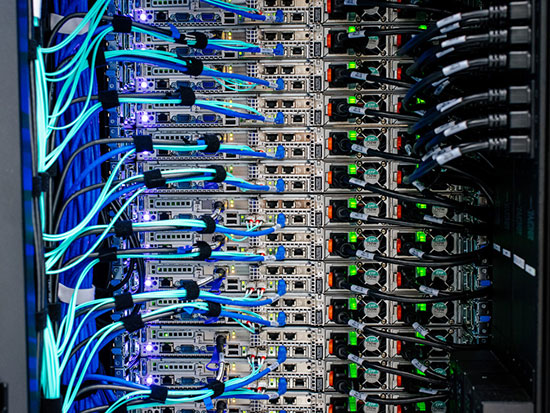 Closeup view of part of CheahaComputer software is playing an increasingly important role in drug development work. “Some programs help us conduct in silico [computer-based] screening of very large virtual compound libraries against drug targets of interest to identify lead compounds,” Velu said. “Other programs help predict the adsorption, distribution and toxicity profiles of new compounds to optimize their drug properties.” After the computer delivers these predictions, “we make those structural modifications to the lead compound to make it more drug-like,” Velu said. If he is studying only a handful of potential drug molecules, this data-crunching can be done on a PC in the lab, Velu explains. A large-scale search for potential new drugs may require sifting through hundreds of thousands of compounds. For this work, Velu uses UAB’s Cheaha supercomputer.
Closeup view of part of CheahaComputer software is playing an increasingly important role in drug development work. “Some programs help us conduct in silico [computer-based] screening of very large virtual compound libraries against drug targets of interest to identify lead compounds,” Velu said. “Other programs help predict the adsorption, distribution and toxicity profiles of new compounds to optimize their drug properties.” After the computer delivers these predictions, “we make those structural modifications to the lead compound to make it more drug-like,” Velu said. If he is studying only a handful of potential drug molecules, this data-crunching can be done on a PC in the lab, Velu explains. A large-scale search for potential new drugs may require sifting through hundreds of thousands of compounds. For this work, Velu uses UAB’s Cheaha supercomputer.
Newer software options such as BioSolveIT’s SeeSAR “really helps students predict” the effectiveness of experimental compounds, Velu said. “Not all are completely accurate, but it really narrows down the number of compounds to test.”
The good news is that drugs to block voltage-gated sodium channels are already on the market. Lidocaine, the numbing spray often used to ease pain for athletes, is one example. But none are designed to target the specific sub-types of these channels seen in cancer. The Velu lab’s most recent project is on medullary thyroid cancer, a form of neuroendocrine cancer with no curative treatment options.
Velu’s lab, in collaboration with two other Cancer Center researchers — Renata Jaskula-Sztul, Ph.D., associate professor in the Department of Surgery, and Anna Sorace, Ph.D., associate professor in the departments of Radiology and Biomedical Engineering — is currently developing effective small-molecule therapies for this cancer. “We found recently that voltage-gated sodium channel subtype Nav1.7 is overexpressed in medullary thyroid cancer cells and patient tissue,” Velu said, while it has very low expression in normal thyroid cells and tissues.
The field of protein science has developed quickly in recent years, “making high-resolution structures of many of these channels currently available in the [online] Protein Data Bank,” Velu said. The graduate student working on this project, Piyasuda Pukkanasut, has generated a model of the Nav1.7 channel subtype and designed small-molecule blockers using this model, Velu said, and “she is currently working on the structure-activity relationship studies to optimize the activity of this lead compound.” That work has earned Pukkanasut a 2022 Women Advancing Thyroid Research Award, which recognizes and celebrates the work of early career investigators conducting outstanding research, Velu says.
Mouse models to evaluate the anti-metastatic activity of the lead compound are a key part of this study. Velu and his student are now working with these models and conducting MRI studies in the Jaskula-Sztul and Sorace labs to evaluate their lead compound’s ability to inhibit metastasis. “We have fantastic images where we saw the compound reducing metastatic lesions in the liver,” Velu said.
The project is supported by the Cancer Center’s O’Neal Invests research support program, which has also funded other promising studies in his lab, Velu said. “The Cancer Center has been very generous in supporting our work with multiple pilot grants.”
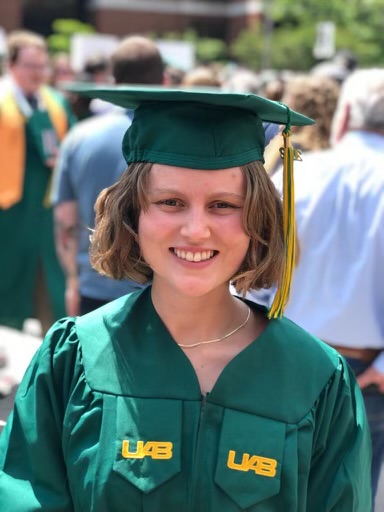 Zoë Evans, one of the first graduates of UAB's Undergraduate Cancer Biology Program.
Zoë Evans, one of the first graduates of UAB's Undergraduate Cancer Biology Program.
Majoring in Cancer Biology
UAB’s Undergraduate Cancer Biology Program, co-directed by Velu, is the only one of its kind in the United States. During their studies, students can take part in cutting-edge research in the Department of Chemistry and across UAB, he notes. “We have a wide range of research mentor labs that our students can choose from as part of the major’s mandatory research component,” he said. “We also offer scholarships through the RACE21 [Roadmap for America’s Cancer Explorers for the 21st Century] program,” which offers paid summer internships in the freshman and sophomore years and even more extensive funding in the junior and senior years. Students in the cancer biology major can take courses in drug discovery, natural product chemistry and advanced biochemistry as electives.
“We had 13 students when we started the program in fall 2020, and now we have more than 90 students,” Velu said. “It has proved to be very popular.”
The program graduated its first two students in spring 2022. Read their stories here.
